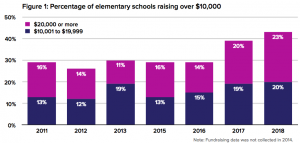The fundraising advantage
A new report from People for Education shows fundraising is causing substantial gaps between schools.
The report – based on survey data from 1,244 Ontario elementary and secondary schools – reveals that elementary schools with low poverty rates raise twice the amount raised by schools with higher poverty rates. This creates a double advantage for students in higher income schools – they come from families that can afford to pay for enrichment opportunities outside of school and they attend schools that fundraise as much as $150,000 per year to provide enrichment at school.
“Fundraising results in Have and Have not [schools]… We do not have field trips and performances in school on a par with other wealthier schools… We have to spend a great deal of time sourcing community partnerships to make up for lack of funds.”
Elementary school, York Region DSB
Fundraising guidelines fail to guard against inequities
In 2018, 99% of elementary and 87% of secondary schools report fundraising for things like charities, busing for school trips, playground and outdoor facilities, technology, the arts, student bursaries and scholarships.
Ontario’s Guideline for School Fundraising specifies that funds raised must be used “to complement, not replace, public funding for education,” and that schools cannot fundraise for things like learning materials and textbooks, or administrative expenses. But the guidelines allow fundraising for things like extra-curricular activities, upgrades to sporting facilities, arts programs, field trips, and playgrounds.
The report raises concerns about the inequities created by fundraising, and points to research by Queen’s University professor Rena Upitis, who says that enriched programs and environments in schools help students develop skills and competencies they might not get from classroom learning alone.
According to the report, the top 10% of fundraising elementary schools raised 37 times the amount raised by the bottom 10%, with some schools raising as much as $123,000. Among secondary schools, the top 5% of fundraising schools raised as much as the bottom 81% combined, with some schools reporting raising $150,000.
Without [parents’] continued efforts, a lot of the extracurricular activities, guest speakers/presenters and special events that take place…could not happen with the current school budget alone.
Elementary school, Toronto DSB
More money raised in more elementary schools
The report also points to a substantial increase in the median amount raised in elementary schools. In 2018, the median amount raised by elementary schools reached an all-time high of $10,000, 25% higher than any other year on record. Almost a quarter of elementary schools raised $20,000 or more, which is also an all-time high, increasing from 16% in 2011.
Family income and its impact on fundraising
This year, People for Education used Statistics Canada data to compare the impact of poverty on fundraising. Comparing the top quarter to the bottom quarter of schools based on the proportion of families below the Low Income Measure, the group found that in schools with high poverty rates, the median amount fundraised is half that of schools with low proportions of low income families.
Parents want to provide the best opportunities for their children. But if the system is to provide every child with an equitable chance for success, it is vital that all students – not just those whose parents can afford it – have access to the programs, resources, and activities that build vital competencies for long-term success. It is time for Ontario to address this key equity question.
Annie Kidder, Executive Director
